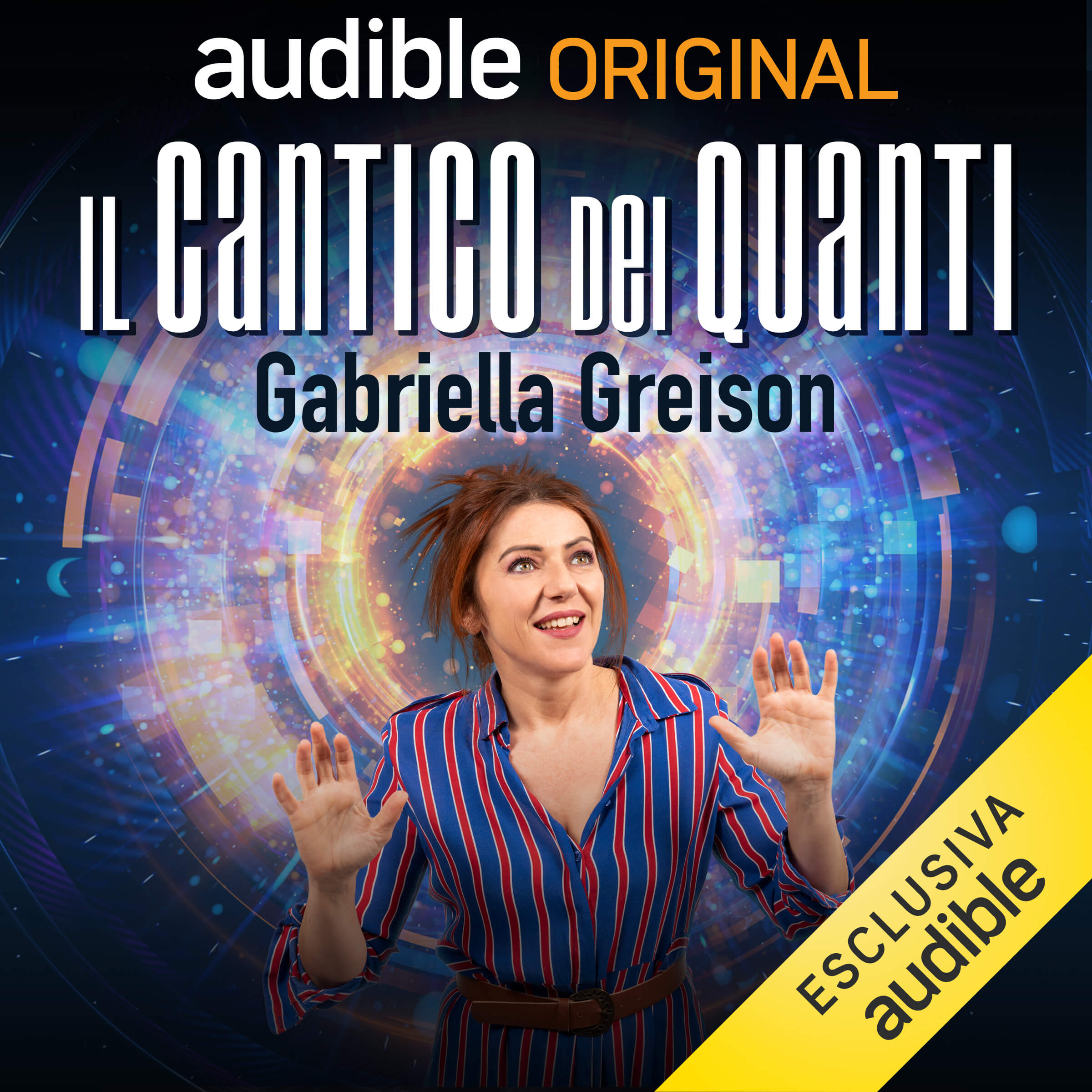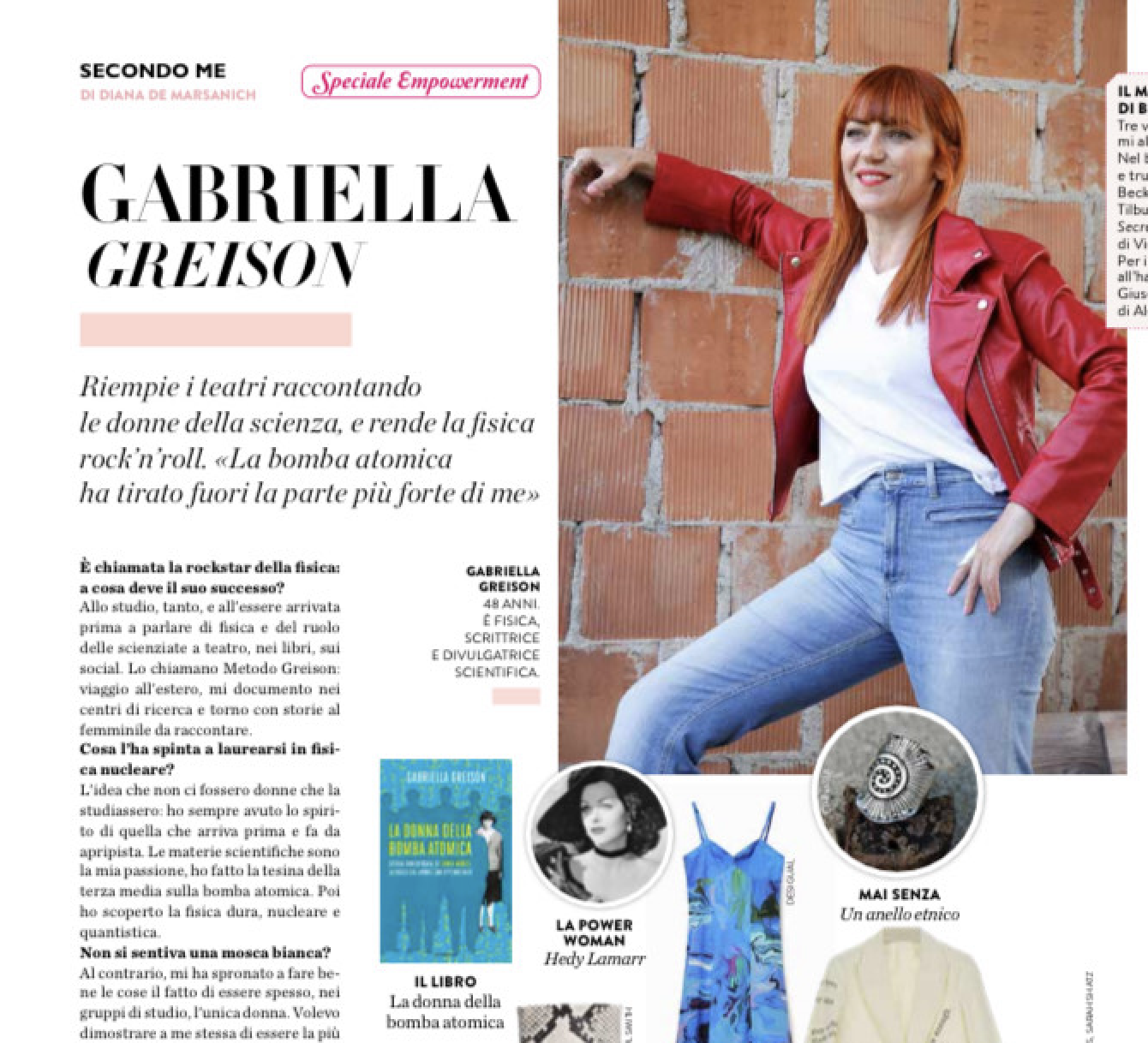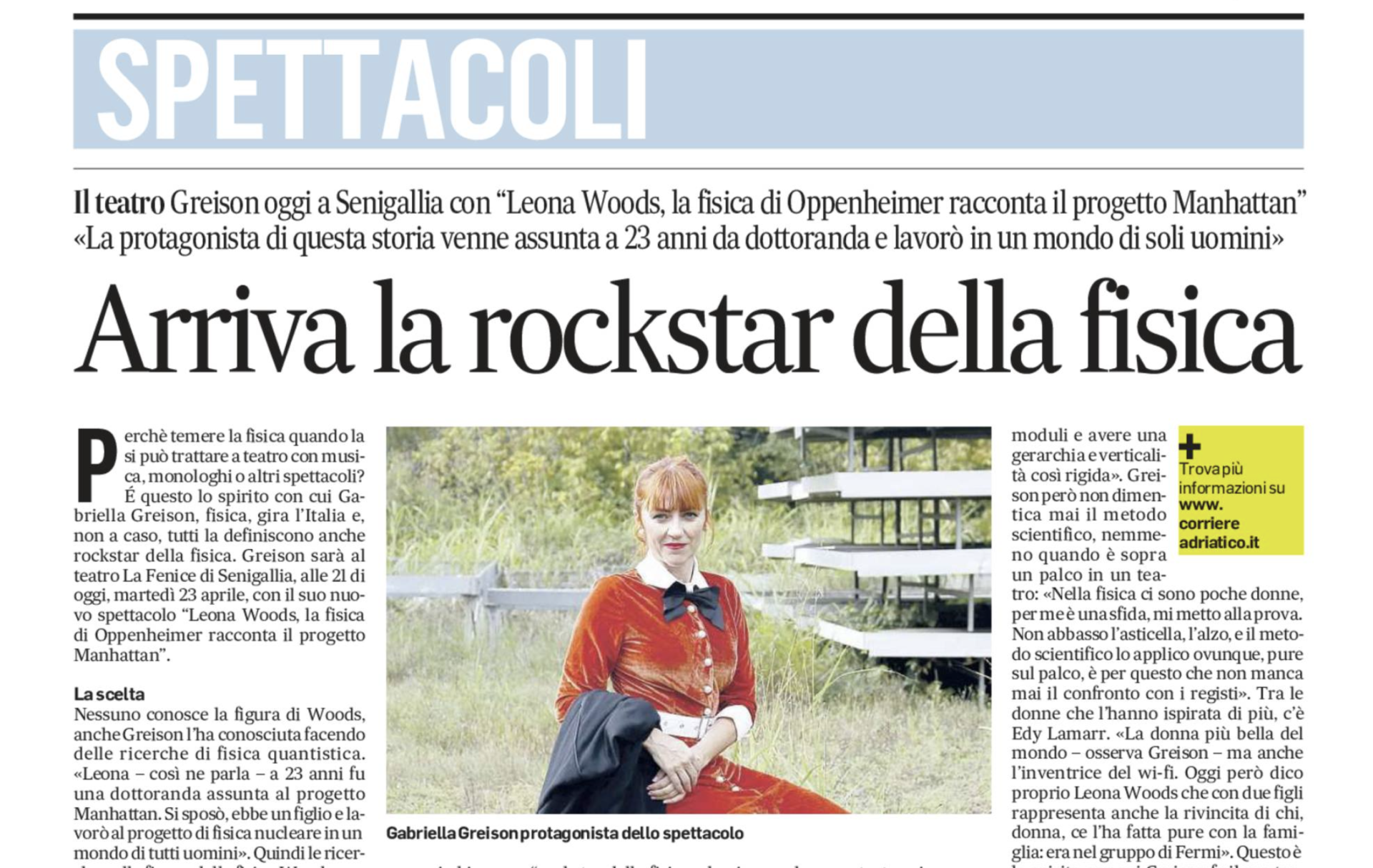Approfondimenti IL CANTICO DEI QUANTI (il podcast per Audible sulla fisica quantistica di Gabriella Greison)
IL CANTICO DEI QUANTI
LA FISICA QUANTISTICA RACCONTATA FACILE DA GABRIELLA GREISON
di Gabriella Greison
produzione Audible
voce di Gabriella Greison
INTRO
Sono Gabriella Greison, sono fisica, sono scrittrice, e racconto a teatro – con i miei monologhi – i fisici del xx secolo, quelli che hanno creato il nostro mondo. Non solo nei miei romanzi, e su un palco teatrale, lo faccio anche in radio e in televisione, quando me lo fanno fare. Ma la cosa buffa, è che stanotte non ho dormito perché stavo per iniziare questa nuova avventura: raccontare la fisica per Audible, su Amazon, sotto forma di podcast, la cosa mi ha elettrizzato così tanto al punto che mi sono fatta venire il raffreddore….sentite che naso tappato, mi sembra la condizione iniziale migliore per iniziare un rapporto di lavoro basato solo sulla mia voce…ve l’assicuro, ho una bella voce, prendiamo questa mia verità come un assunto matematico (senza bisogno che ve lo dimostri).
Dunque. Non c’è un palco, non c’è un copione, non c’è lavagna o gessetti, ma ho davanti solo i miei appunti, appunti di una vita passata a studiare fisica (non perché io mi sia laureata in tanti anni, ma perché ho continuato anche dopo la laurea a studiarla), poche formule, e tanta immaginazione. “La scienza è immaginazione” diceva Einstein, è questo il mio approccio infatti, prima le immagino io le cose, e poi solo così posso raccontarle a voi: e solo un fisico riesce ad immaginare così tanto la scienza, nessun altro…
Dicevo, sono stata chiamata da Audible per creare questi podcast ‘iniziando in particolare dalla fisica quantistica’, il modo migliore per essere semplici e chiari nel raccontarla, ho pensato, senza niente, soltanto la voce e la fantasia. Tutto questo è perfetto per la fisica quantistica. Il titolo che ho pensato per questo podcast è “Il cantico dei quanti”, (sottotitolo: la fisic quantistica raccontata facile da GG). ‘facile’, questo è un corso base, diciamo così. Perché c’è anche una versione ‘difficile’ o ‘avanzata’ per raccontare la fisica quantistica. Inizio da questa, per fare avvicinare tutti: chiunque può ascoltare questo podcast, ve l’assicuro. Che poi la fisica sia il futuro e che secondo me dovremmo metterci qui e raccontarla tutta, questo è il mio chiodo fisso…ma va beh, iniziamo dalla fisica quantistica. Un bell’azzardo, visto che al liceo si smette di studiare fisica proprio quando si finisce l’ettromagnetismo e le equazioni di Maxwell, mica si approfondisce oltre… E’ per questo che questi podcast vanno bene per tutti, si abbinano su tutto tutto, diciamo così…la fisica quantistica è come una giacca di pelle o il colore verde, stanno bene su tutto.
Non aspettatevi lezioni pedanti, in cui il prof si gira di spalle e voi potete lanciare palle di carta a chi vi sta di fianco, primo perché io non posso vedervi, e poi perché la fisica che vi racconto io è bellissima. Il mio metodo ‘rivoluzionario’ – lo chiamano così i giornali quando parlano di me – sta nell’immaginare la scienza, e nel rendere la fisica un posto abitabile. I ‘paludati accademici’ o i ‘cattedratici annoianti’, come li chiamava Einstein, con la barba bianca, non vanno più bene al giorno d’oggi. Oggi ci sono film, serie tv che arrivano dall’america che parlano di fisica con altro linguaggio. E io mi allineo a loro…
Il mio ‘metodo’ consiste anche nelle contaminazioni. Esattamente come facevo le lezioni in classe ai tempi in cui le facevo (quando mi invitano all’università salgo sulla cattedra, ma quella è una questione di punti di vista, mi consente di farmi vedere da tutti), nei licei mettevo invece la musica all’inizio e alla fine della lezione… per segnare il terreno, per tracciare un solco per terra, una linea di demarcazione tra quello che ci è stato detto finora e quello che vi racconto io… Siamo circondati da informazioni, la mia lezione vuole essere una parentesi nella giornata in cui dico cose diverse… (siamo circondati anche da chi la scienza ce la fa odiare, e poi ci sono i luoghi comuni che aleggiano intorno alla fisica…io cercherò di scardinarli tutti, uno ad uno… saranno simpatiche digressioni nei vari episodi: con la fisica non si trova lavoro, con la scienza non si mangia…quante scemenze…in america avere in un gruppo di lavoro un fisico è un valore aggiunto inestimabile, una pepita preziosa, il punto di vista di un fisico è qualcosa che vale più dell’oro…). Ma siccome non posso realmente mettere la musica, allora vi dirò solo la canzone, il titolo e l’autore, che ben si addice al racconto della puntata…
Sul mio sito ho messo il link per scaricare le puntate da Amazon, e ho messo anche degli extra: le musiche che cito, le formule che ometto, i passaggi più ostici, le dimostrazioni di alcune equazioni.
Perchè ho scelto questo titolo. Il “cantico dei cantici” (song of song, o song of salomone) è uno dei libri della Bibbia, ebraica e cristiana, è il poema d’amore più letto e tradotto al mondo, è anche il più misterioso. Niente di meglio che associare la fisica al mistero, lo fanno già in tanti. E l’amore nel caso di “il cantico dei quanti’ è mio nei confronti della fisica quantistica, oppure tra me, la fisica quantistica e audible, oppure tra me, la fisica audible e voi.
Nel CDC ci sono 8 poemi, 8 episodi, noi ne avremo 16, 16 episodi, 16 storie. Non perchè ripeto le cose due volte (lo sapete che Einstein da bambino lo faceva, ripeteva le cose due volte come se gli altri non capissero le cose che diceva…certo era Einstein fin da bambino), ma perché uso più parole: la fisica quantistica, così come le favole o i sogni, ha una trama bellissima: e quindi è necessario seguirla con più calma, e l’uso di più parole.
Le parole, la terminologia che uso è uno degli aspetti che riguardano il mio metodo di racconto. C’è una terminologia ben precisa che i fisici hanno sempre usato, che li differenzia da tutti gli altri perché la sanno maneggiare bene, io essendo fisica l’ho dovuta imparare quella terminologia…ma come faccio nei miei monologhi certi termini li dico ma poi li butto via, come dire: sappiate che ci sono, ma a volte se ne può fare a meno…
Andrò a braccio, in ogni episodio. Come vi ho detto ho davanti i miei appunti e basta… Ma ora, iniziamo.
1) LUCE E MATERIA – > clicca qui
Massive Attack – Unfinished Sympathy
Alcuni dei personaggi citati:
Empedocle (495 ac – 444 ac)
James Clerk Maxwell (1831-1879)
Heinrich Hertz (1857–1894)
Ernest Rutherford (1871– 1937)
In questo episodio ridefinisco la luce e la materia secondo la fisica quantistica
2) LA COSTANTE DI PLANCK -> clicca qui
AIR – CHERRY BLOSSOM GIRL
In questo episodio: definizione di corpo nero, Max Planck e la sua formula, la fisica quantistica sta per nascere…
(il gioco con alcune sostituzioni nelle formule è utile per prendere dimestichezza con le grandezze in gioco, lo lascio a voi)
Cosa da approfondire:
legge di Rayleigh-Jeans
formula di Planck
la costante h
3) L’EFFETTO FOTOELETTRICO -> clicca qui
AIR – Alone in Kyoto
Approfondimenti:
Albert Einstein e la sua intuizione: supponiamo che la luce si propaghi sotto forma di quanti di energia (oggi noti con il nome di fotoni) e studiamola così…
(le formule che cito servono solo per esercizio, sono formule di immediata comprensione una volta scritte)
4) LA DOPPIA FENDITURA – > clicca qui
AIR – Run
Approfondimenti:
Thomas Young (1773–1829)
Christian Huygens (1629–1695)
Esperimento con la doppia fenditura per luce e materia
5) DE BROGLIE E L’EFFETTO COMPTON – > clicca qui
Hugo Race – Ghostwriter
Approfondimenti:
Louis de Broglie (1892 -1987)
Arthur Compton (1892–1962)
6) LA SCUOLA DI COPENAGHEN E IL PRINCIPIO DI INDETERMINAZIONE DI HEISENBERG – > clicca qui
Ethienne Daho – L’invitation
Approfondimenti: Niels Bohr, scuola di Copenaghen, Werner Heisenberg, Wolfgang Pauli, il principio di indeterminazione di Heisenberg, il principio di Esclusione di Pauli…
7) IL DUALISMO ONDA PARTICELLA E IL COLLASSO DELLA FUNZIONE D’ONDA – > clicca qui
Camille Baz Baz – Sur le boute de la langue
Approfondimenti: il dualismo onda particella, definizione di funzione d’onda, la materia e la luce continuano a essere messi in discussione…
8) IL MODELLO ATOMICO DI BOHR – > clicca qui
Baz Baz – Infinie solitude
Approfondimenti:
Niels Bohr (1885–1962)
Max Born (1882-1970)
La stabilità dell’atomo, gli orbitali atomici…
9) IL DIBATTITO TRA EINSTEIN E BOHR – > clicca qui
AIR – Universal traveler
Approfondimenti:
Albert Einstein (1879-1955)
Teoria ortodossa della fisica quantistica
La probabilità e il caso
10) L’EQUAZIONE DI SCHROEDINGER – > clicca qui
AIR – Alpha beta gaga
Approfondimenti:
La funzione d’onda, l’equazione di Schroedinger, Erwin Schroedinger (1887-1961), il paradosso del gatto di Schroedinger…
11) IL GATTO DI SCHROEDINGER – > clicca qui
Baz Baz – Souviens toi
Approfondimenti: il libro di Schroedinger che cito è “Mente e materia”
12) FORMALISMO QUANTISTICO E ALTRI PROTAGONISTI – > clicca qui
AIR – Mike Mils
Dall’ampio ventaglio di possibili interpretazioni fisiche del formalismo della meccanica quantistica si possono estrarre alcune linee guida e ripartire lo scenario nei seguenti filoni principali:
– l’interpretazione di Copenaghen, che è considerata per eccellenza l’interpretazione ortodossa standard della meccanica quantistica (Bohr, Heisenberg e altri);
– le teorie delle variabili nascoste, che cercano di ricondurre la meccanica quantistica consueta a parametri nascosti locali e realistici;
– la meccanica di Bohm, che, attraverso un’estensione dell’usuale meccanica quantistica con l’aggiunta di onde pilota, arriva a una formulazione deterministica non locale della dinamica, nella quale la funzione d’onda assume un significato reale (de Broglie, Bohm e altri);
– le teorie di localizzazione spontanea, o le esplicite teorie del collasso fisico, che introducono un nuovo meccanismo fisicamente reale per il collasso, attraverso una modificazione dell’equazione di Schrödinger (Pearle, Ghirardi, Rimini, Weber e altri);
– l’interpretazione degli stati relativi, anche detta interpretazione a molti mondi, che rappresenta una lettura alternativa del formalismo matematico (Everett, DeWitt e altri);
– la teoria delle storie quantistiche consistenti, che (pressappoco come nell’interpretazione degli stati relativi) priva il processo di misurazione, da parte di un osservatore esterno, di quello status centrale che invece la maggioranza delle altre teorie gli riconosce (Griffith, Omnès e altri).
13) ALTRE INTERPRETAZIONI – > clicca qui
Massive Attack – Butterfly caught
Approfondimenti:
Hugh Everett (1930– 1982)
Bryce DeWitt (1923–2004)
14) EPR – > clicca qui
Massive Attack – Rising song
Approfondimenti:
il saggio di Einstein, Podolsky e Rosen
la teoria di Bohm
15) LE DISUGUAGLIANZE DI BELL – > clicca qui
Charles Trenet – Boom
Dal punto di vista della meccanica quantistica, lo stato di una coppia di particelle A e B generate in questo modo può essere descritto come segue. Lo stato di un qualunque sistema composto, relativo a diversi oggetti quantistici, e costituito dai due sotto- sistemi 1 e 2, aventi stati |Ψ1⟩ e |Ψ2⟩ rispettivamente, è dato dal prodotto dei singoli stati componenti. Nella notazione di Dirac, lo stato risultante si esprime come:
|Ψ⟩=|Ψ1⟩·|Ψ2⟩
16) CONSEGUENZE QUANTISTICHE – > clicca qui
Air – Angel
Approfondimenti: computer quantistici, crittografia quantistica e tanto altro…
I poeti citati: Italo Calvino, Charles Baudelaire, Robert Frost.
Per i miei libri letti da me:
-> PER ASCOLTARE “L’INCREDIBILE CENA DEI FISICI QUANTISTICI” CLICCA!
-> PER ASCOLTARE “SEI DONNE CHE HANNO CAMBIATO IL MONDO” CLICCA!
-> PER ASCOLTARE “HOTEL COPENAGHEN” CLICCA!
-> PER ASCOLTARE “SUPERDONNE” CLICCA!
-> PER ASCOLTARE “EINSTEIN E IO” CLICCA!
-> PER ASCOLTARE “LA LEGGENDARIA STORIA DI HEISENBERG E DEI FISICI DI FARM HALL” CLICCA!
-> PER ASCOLTARE “EINSTEIN FOREVER” CLICCA!
E i podcast:
Per IL CANTICO DEI QUANTI -> CLICCA QUI
Per CARA MARIE CURIE… -> CLICCA QUI
BIBLIOGRAFIA
Académie des Sciences. La Découverte des ondes de matière, Actes du Colloque Louis de Broglie, Parigi, 16-17 juin 1992. Paris: Lavoisier, 1994.
Abragam, Anatole. “Louis Victor Pierre Raymond de Broglie, 15 August 1892–19 March 1987”, Biographical Memoirs of Fellows of the Royal Society, 1988.
Aitchison, Ian J.R., David A. MacManus and Thomas M. Snyder, 2004, “Understanding Heisenberg’s ‘Magical’ Paper”.
Bacciagaluppi, Guido, and Antony Valentini, Quantum Theory at the Crossroads: Reconsidering the 1927 Solvay Conference, Cambridge University Press, 2009.
Badash, Lawrence, 1972, “The Completeness of Nineteenth-Century Science”.
Bell John S., 1987, Speakable and Unspeakable in Quantum Mechanics, Cambridge University Press.
Beller, Mara, 1990, “Born’s Probabilistic Interpretation: A Case Study of ‘Concepts in Flux’”.
Beller, Mara, 1996, “The Conceptual and the Anecdotal History of Quantum Mechanics”.
Beller, Mara, 1999a, Quantum Dialogue: The Making of a Revolution, University of Chicago Press.
Beller, Mara, 1999b, “Jocular Commemorations: The Copenhagen Spirit” Osiris.
Beranek William (ed.), 1987, Science, Scientists, and Society, Bogden and Quigley, New York.
Berg A. Scott, 2000, Lindbergh, l’aquila solitaria, Mondadori, Milano (ed. or. Lindbergh, G.P. Putnam’s Sons, New York 1998).
Bernstein, Jeremy, 2005, “Max Born and the Quantum Theory” American Journal of Physics, 73.
Beyler, Richard H., 1996, “Targeting the Organism: The Scientific and Cultural Context of Pascual Jordan’s Quantum Biology, 1932–1947”.
Bird Kai, Sherwin Martin J., 2007, Robert Oppenheimer, il padre della bomba atomica: il trionfo e la tragedia di uno scienziato, Garzanti, Milano.
Blackett Patrick M., Occhialini Giuseppe, 1933, «Some Photographs of the Tracks of Penetrating Radiation», Proceedings of the Royal Society of London.
Blackmore, John, 1985, “An Historical Note on Ernst Mach” British Journal for the Philosophy of Science, 36.
Blair Bolles, Edmund, 2004, Einstein Defiant: Genius versus Genius in the Quantum Revolution, Joseph Henry Press.
Bloch, Felix, 1976, “Heisenberg and the Early Days of Quantum Mechanics” Physics Today, 29.
Blumberg Stanley, Owens Gwinn, 1976, Energy and Conflict: The Life and Times of Edward Teller, Putnam, New York.
Born, Gustav, 2002, “The Wide-Ranging Family History of Max Born,” Notes and Recordings of the Royal Society of London, 56.
Born, Max, 1969, Physics in My Generation, Springer Verlag.
Born Max, Einstein Albert, 1973, Scienza e vita: lettere 1916-1955, Einaudi, Torino.
Boutin, Paul, 2005, “Theory of Anything? Physicist Lawrence Krauss Turns on His Own”.
Bowen, Marshall, and Joseph Coster, 1980, “Born’s Discovery of the Quantum-Mechanical Matrix Calculus”, American Journal of Physics, 48.
Boya, Luis J., 2003, “Rejection of the Light Quantum: The Dark Side of Niels Bohr” International Journal of Theoretical Physics, 42, No. 10.
Broglie Louis de, 1963, Recherches sur la Theorie des Quanta, Masson, Paris.
Brown Laurie, 1978, «The Idea of the Neutrino», Physics Today, September.
Brown Laurie, Pais Abraham, Pippard Brian (eds), 1995, Twentieth century physics, 3 voll., American Institute of Physics, New York.
Brown Laurie, Rigden John (eds), 1993, Most of the Good Stuff: Memories of Richard Feynman, American Institute of Physics, New York.
Brush, Stephen G., 1980, “The Chimerical Cat: Philosophy of Quantum Mechanics in Historical Perspective,” Social Studies of Science, 10, No. 4.
Canady John, 2000, The Nuclear Muse, University of Wisconsin Press, Madison.
Casimir Hendrik, 1983, Haphazard Reality: Half a Century of Science, Harper & Row, New York.
Cassidy, David C., 1992, Uncertainty: The Life and Science of Werner Heisenberg, W.H. Freeman and Company.
Cathcart Brain, 2005, The Fly in the Cathedral, Farrar, Straus and Giroux, New York.
Chadwick James, 1932a, «Possible Existence of the Neutron»,Nature, 129.
Cline, Barbara Lovett, 1965, Men Who Made a New Physics, University of Chicago Press.
Comte, Auguste, 1842, A General View of Positivism, 1957, tr. J.H. Bridges, Robert Speller and Sons.
Curie Irène, Joliot Frédéric, 1932, «Émission de protons de grande vitesse par les substances hydrogénées sous l’influence des rayons Á trés pénétrants», Comptes Rendus de l’Académie des Sciences, 194.
Cornwell, John, 2003, Hitler’s Scientists, Viking.
Curtis, Theodor, 1961, “Robert Bunsen,” in Great Chemists, ed. Eduard Farber, Interscience.
Cormier-Delanoue, Christian. Louis de Broglie que nous avons connu. Paris: Fondation Louis de Broglie, 1988.
Darrigol, Olivier. “Stranezza e solidità nei lavori di Louis de Broglie” Physis 30 (1993): 303-372.
Dalitz, R.H., and Rudolph Peierls, 1986, “Paul Adrien Maurice Dirac, 8 August 1902–20 October 1984,” Biographical Memoirs of Fellows of the Royal Society.
De Broglie, Louis, Onde e movimenti. Paris: Gauthier-Villars, 1926.
De Broglie, Louis,La mécanique ondulatoire. Paris: Gauthier-Villars, 1928.
De Broglie, Louis, Materia e Luce; Nuova Fisica. London: Allen & Unwin, 1939.
de Regt, Heck W., 1991, “Erwin Schrödinger, Anschaulichkeit, and Quantum Theory,” Studies in History and Philosophy of Modern Science, 28, No. 4.
Dirac, Monica, 2002, on the occasion of the centennial celebration of Paul Dirac’s career at Cambridge University.
Dresden, Max, 1987, H.A. Kramers—Between Tradition and Revolution, Springer Verlag.
Ebeling, Werner, and Dieter Hoffman, 1991, “The Berlin School of Thermodynamics Founded by Helmholtz and Clausius” European Journal of Physics, 12.
Eckert, M., 2000, “The Emergence of Quantum Schools: Munich, Göttingen and Copenhagen as New Centers of Atomic Theory” Annalen der Physik, 10, No. 1–2.
Einstein, Albert, 1919, tr. Bertram Schwarzschild, 2005, “Albert Einstein to Paul Ehrenfest” Physics Today, 58, No. 4.
Einstein, Albert, 1959, “Autobiographical Notes” in Albert Einstein: Philosopher-Scientist, ed. Paul Arthur Schlipp, Harper & Brothers.
Einstein, Albert, 1995, The Collected Papers of Albert Einstein, Vol. 5, The Swiss Years: Correspondence, 1902–1914, tr. Anna Beck, Princeton University Press.
Einstein, Albert, and Max Born, 1971, The Born–Einstein Letters, Walker and Company.
Elsasser,Walter, 1978, Memories of a Physicist in the Atomic Age, Science History Publications.
Enz, Charles P., 2000, “Wolfgang Pauli–Carl Gustav Jung, a Dialogue over the Boundaries” Wolfgang Pauli and Modern Physics, ETH-Bibliothek.
Fermi Enrico, 1965, Note e memorie-Collected papers, 2 vol., Accademia nazionale dei Lincei.
Fermi Laura, 1965, Atomi in famiglia, Mondadori, Milano.
Feynman Richard, 2007, La fisica di Feynman, 3 vol., Zanichelli, Bologna.
Fierz Marcus, Weisskopf Victor (eds), 1960, Theoretical Physics in the Twentieth Century: A Memorial Volume to Wolfgang Pauli, Interscience Publishers, New York.
Fischer Ernst, Lipson Carol, 1988, Thinking About Science: Max Delbrück and the Origins of Molecular Biology, W.W. Norton, New York.
Frank, Philipp, 1941, Between Physics and Philosophy, Harvard University Press.
Funk, Herbert, 2000, “Wolfgang Pauli—A Biographical Sketch” Wolfgang Pauli and Modern Physics, ETH-Bibliothek.
Galison Peter, Hevly Bruce, 1992, Big Science: The Growth of Large-scale Research, Stanford University Press, Stanford, CA.
Gamow George, 1931, Constitution of Atomic Nuclei and Radioactivity, Clarendon Press, Oxford.
Gehrenbeck, Richard K., 1978, “Electron Diffraction: Fifty Years Ago,” Physics Today, 31.
George, André. Louis de Broglie: physicien et penseur. Paris: 1953. Gerber, Johannes”.
Geschichte der Wellenmechanik “Archivio per la storia delle scienze esatte” (1969): 349-416.
Gershenson, Daniel E., and Daniel A. Greenberg, 1964, “The Physics of the Eleatics,” in The Natural Philosopher, Vol. 3, ed. Daniel E. Gershenson and Daniel A. Greenberg, Blaisdell Publishing Company.
Gingras, Yves, 2001, “What Did Mathematics Do to Physics?” History of Science, 39.
Goudsmit, Samuel, 1971, “The Discovery of the Electron Spin, a Lecture Presented to the Dutch Physical Society”.
Greene, Brian, 2000, The Elegant Universe, Vintage Books.
Gross, David, Marc Hanneaux and Alexander Sevrin, 2007, The Quantum Structure of Space and Time: Proceedings of the 23rd Solvay Conference on Physics, Brussels, Belgium, 1–3 December 2005, World Scientific Publishing Company.
Halpern, Paul, 2004, “Nordström, Ehrenfest and the Role of Dimensionality in Physics”, Physics in Perspective, 6, No. 4.
Halpern, Paul, 2006, “Brotherly Advice: Letters from Hugo to Paul Ehrenfest in His Final Years” presented at the American Physical Society March Meeting, March 16, 2006, Baltimore, Maryland.
Hahn Otto, 1970, My life, Herder and Herder, New York.
Harper Eamon, Parke W.C., Anderson G.D. (eds), 1997, The George Gamow Symposium, Astronomical Society of the Pacific Publications, San Francisco.
Harris, Richard, 2007, “Short of ‘All,’ String Theorists Accused of Nothing”, National Public Radio, August 27, 2007.
Heilbron, John L., and Thomas S. Kuhn, 1969, “The Genesis of the Bohr Atom” in Historical Studies in the Physical Sciences, ed. Russell McCormmach, University of Pennsylvania Press.
Heisenberg, Werner, 1971, Physics and Beyond: Encounters and Conversations, Harper and Row.
Hendry, John, 1984, The Creation of Quantum Mechanics and the Bohr–Pauli Dialogue, D. Reidel Publishing Company.
Highfield, Roger, and Paul Carter, 1993, The Private Lives of Albert Einstein, Faber and Faber.
Hoffman, Banesh, with Helen Dukus, 1972, Albert Einstein: Creator and Rebel, Plume (Penguin Books).
Holton, Gerald, 1992, “Ernst Mach and the Fortunes of Positivism in America” No. 1.
Holton, Gerald, 2003, “Einstein’s Third Paradise” Daedalus, 132.
Holton, Gerald, 2004, “Paul Tillich, Albert Einstein, and the Quest for the Ultimate” The Paul Tillich Lecture, Harvard University.
Honner, John, 1982, “The Transcendental Philosophy of Niels Bohr” Studies in History and Philosophy of Science, 13, No. 1.
Howard, Don, 2005, “Revisiting the Einstein–Bohr Dialogue” from a Bar-Hillel.
Huijnen, Pim, and A.J. Knox, 2007, “Paul Ehrenfest’s Rough Road to Leiden: A Physicist’s Search for a Position, 1904–1912” Physics in Perspective, 9.
Jacobi, Manfred, 2000, “Wolfgang Pauli’s Family Background” Gesnerus, 57, N. 3–4.
James, William, 1926, The Letters of William James, ed. Henry James, Little Brown.
Johnson, George, 2007, “Meta Physicists” The New York Times Book Review, June 24, 2007.
Jones, Sheilla, Quantum Ten, Thomas Allen Pubblishers, 2008.
Jordan, Pascual, 1975, “My Recollections of Wolfgang Pauli”, American Journal of Physics, 43, No. 3.
Kalckar, Jørgen, 1985, Foundations of Quantum Mechanics I (1926–1932), North-Holland Publishing Company.
Klein, Étienne, 1997, Conversations with a Sphinx: Paradoxes in Physics, tr. David Le Vay, Souvenir Press.
Klein, Martin J., 1964a, “Einstein’s First Paper on Quanta” in The Natural Philosopher, Vol. 11, ed. Daniel E. Gershenson and Daniel A. Greenberg, Blaisdell Publishing Company.
Klein, Martin J., 1964b, “Planck, Entropy and Quanta, 1901–1906” in The Natural Philosopher, Vol. 1, ed. Daniel E. Gershenson and Daniel A. Greenberg, Blaisdell Publishing Company.
Klein, Martin J., 1964c, “Einstein and Wave-Particle Duality” in The Natural Philosopher, Vol. 3, ed. Daniel E. Gershenson and Daniel A. Greenberg, Blaisdell Publishing Company.
Klein, Martin J., 1970a, Paul Ehrenfest, Vol. 1, The Making of a Theoretical Physicist, North-Holland Publishing Company.
Klein, Martin J., 1970b, “The First Phase of the Bohr–Einstein Dialogue” Historical Studies in the Physical Sciences, Vol. 2.
Klein, Martin J., 1981, “Not By Discoveries Alone: The Centennial of Paul Ehrenfest” Physica, 106A.
Klein, Martin J., 1986, “Great Connections Come Alive: Bohr, Ehrenfest and Einstein” in The Lessons of Quantum Theory, eds. J. de Boer, E. Dal, and O. Ulfbeck, Elsevier Science Publishers.
Klein, Martin J., and Allan Needell, 1977, “Some Unnoticed Publications by Einstein” No. 4.
Kragh, Helge, 1990, Dirac: A Scientific Biography, Cambridge University Press.
Kragh, Helge, 1999, Quantum Generations, Princeton University Press.
Langevin, Paul, and Maurice de Broglie, eds., 1912, Proceedings First Solvay Conference, Gauthier-Villars.
Kragh, Helge. “L’eredità di Louis de Broglie nelle opere di Schrödinger e di altri teorici.” A La Découverte des ondes de matière: Colloque organisé à l’occasione du Centenaire de la naissance de Louis de Broglie, 16-17 juin 1992 a cura di Académie des sciences, 65-78. Paris: Lavoisier, 1994.
Levenson, Thomas, 2003, Einstein in Berlin, Bantam Books.
Lightman, Alan, 2005, “Metaphor in Science” cap. 3 in A Sense of the Mysterious: Science and the Human Spirit, Pantheon.
Lindley, David, 2007, Uncertainty: Einstein, Heisenberg, Bohr, and the Struggle for the Soul of Science, Doubleday.
Livanova Anna, 1980, Landau: A Great Physicist and Teacher, Oxford University Press, Oxford.
Lochak, Georges. Louis de Broglie: un principe de la scienza. Paris: Flammarion, 1992.
Luria Salvador, 1984, Storia di geni e di me, Bollati Boringhieri, Torino.
Mach, Ernst, 1886, The Analysis of Sensations, 1914, 4th ed., Open Court.
Mach, Ernst, 1905, Knowledge and Error, tr. Erwin N. Heibert, 1976, Reidel Publishing Company.
Marlowe Christopher, 2004, Il dottor Faust (1604), a c. di Nemi D’Agostino, Mondadori, Milano.
Medicus, Heinrich A. Physics Today 27 (1974) “Cinquanta anni di onde di materia.”: 38-45.
Mehra, Jagdish, 1975, in The Solvay Conferences of Physics, Reidel Publishing Company.
Meyenn, Karl von, and Engelbert Schucking, 2001, “Wolfgang Pauli” Physics Today, 54, No. 2.
Moore, Ruth, 1966, Niels Bohr: The Man, His Science, and the World They Changed, Alfred A. Knopf.
Moore, Walter, 1989, Schrödinger, Life and Thought, Cambridge University Press.
Neffe, Jürgen, 2007, Einstein, tr. Shelley Frisch, Farrar, Straus and Giroux.
Nye, Marie Jo. “La cultura aristocratica e la ricerca della scienza: Il de Broglies in Modern Francia”, 1997.
Ogilvie, Marilyn Bailey, and Joy Dorothy Harvey, eds., 2000, “Ehrenfest-Afanassjewa, Tatyana Alexeyevna (1876–1964)” The Biographical Dictionary of Women in Science, Taylor & Francis.
Ostwald, Wilhelm, 1927, Lebenslinien—Eine Selbstbiographie, Vol. 2, Klassing.
Pais, Abraham, 1982, The Science and the Life of Albert Einstein, Oxford University Press.
Pais, Abraham, 1991, Niels Bohr’s Times: In Physics, Philosophy, and Polity, Clarendon Press.
Pais, Abraham, Maurice Jacob, David I. Olive and Michael F. Atiyah, eds., 1998, Paul Dirac: The Man and His Work, Cambridge University Press.
Peat, F. David, 1987, Synchronicity, Bantam Books.
Peierls, R.E., 1960, “Wolfgang Ernst Pauli, 1900–1958” Biographical Memoirs of Fellows of the Royal Society, 5.
Perutz Max, 1998, I Wish I’d Made You Angry Earlier: Essays on Science, Scientists, and Humanity, Cold Spring Harbor Laboratory, Usa.
Przibram K. (ed.), 1963, Briefe zur Wellenmechanik. Schrödinger, Planck, Einstein, Lorentz, Springer, Wien.
Philip, E.B., 1956, “The Nature of Mathematics” in The World of Mathematics, Vol. 1, ed. James R. Newman, Simon and Shuster.
Poincaré, Henri, 1905, “The Theories of Modern Science” Science and Hypothesis,Walter Scott. Publishing.
Quinn, Susan, 1995, Marie Curie: A Life, Addison Wesley.
Raman, V.V., and Paul Forman, 1969, “Why Was It Schrödinger Who Developed de Broglie’s Ideas?” in Historical Studies in the Physical Sciences, ed. Russell McCormmach, University of Pennsylvania Press.
Reiter, Wolfgang L., 2007, “Ludwig Boltzmann: A Life of Passion” Physics in Perspective, 9.
Richardson, O.W., 1929, “Hendrik Antoon Lorentz” Journal of the London Mathematical Society, 4, No. 1.
Rigden, John S., 2005, Einstein 1905: The Standard of Greatness, Harvard University Press.
Richter Stefan, 1979, Wolfgang Pauli: Die Jahre 1918-1930, Sauerländer, Aarau.
Rozental Stefan (ed.), 1967, Niels Bohr: His Life and Work As Seen By His Friends and Colleagues, North Holland, Amsterdam.
Rutherford Ernest, 1919, «Collisions of Alpha Particles with Light Atoms», Philosophical Magazine, 37.
Rubin, Harry, 1995, “Walter M. Elsasser, Biographical Memoirs” National Academy of Sciences, Vol. 68.
Schroer, Bert, 2007, “Pascual Jordan, Biographical Notes, His Contributions to Quantum Mechanics and His Role as a Protagonist of Quantum Field Theory”.
Pascual Jordan (1902–1980), Max Planck Institute for the History of Science, Preprint 329.
Segrè Emilio, 1988, Enrico Fermi, fisico: Una biografia scientifica, Zanichelli, Bologna.
Segrè, Gino, 2007, Faust in Copenhagen: A Struggle for the Soul of Physics, Viking.
Seppi, Ruth, 2004, “Viennese Feuilleton during the Early 1920s: Description and Analysis of Bertha Pauli’s Biographical Sketches as Contributions to a Literary Genre” thesis, Brigham Young University.
Smolin, Lee, 2006, The Trouble with Physics: The Rise of String Theory, the Fall of a Science, and What Comes Next, Houghton Mifflin. Smutn´y, Frantiˇsek, 1990, “Ernst Mach and Wolfgang Pauli’s Ancestors in Prague” European Journal of Physics, 11.
Snow Charles P., 1968, Ogni sorta di gente: Rutheford, G.H. Hardy, H.G. Wells, Einstein, Lloyd George, Winston Churchill, Robert Frost, Dag Hammarskjold, Stalin, De Donato, Bari.
Stuewer, Roger H., 2006, “Einstein’s Revolutionary Light-Quantum Hypothesis” Acta Physica Polonica B, 37, No. 3.
Taylor, Simon, 1983, Germany 1918–1933, Duckworth.
’t Hooft, Gerard, 2001, “Can There Be Physics without Experiments? Challenges and Pitfalls” International Journal of Modern Physics A, Vol. 16.
Thorndike Greenspan, Nancy, 2005, The End of the Certain World: The Life and Science of Max Born, Basic Books.
Uhlenbeck, George, 1956, “Reminiscences of Professor Paul Ehrenfest” American Journal of Physics, 24, No. 6.
van Lunteren, Frans, 2001, “Paul Ehrenfest and Dutch Physics in the Interwar Period” a talk given at the Annual Meeting of the History of Science Society, Vancouver.
Weinberg, Steven, 1992, Dreams of a Final Theory, Random House.
Weinberg, Steven, 2003, “Viewpoints on String Theory” published by NOVA
Wilson David, 1983, Rutherford: Simple Genius, Hodder and Stoughton, London
Wolpert, L., 1993, The Unnatural Nature of Science, Harvard University.
Per i miei libri letti da me:
-> PER ASCOLTARE “L’INCREDIBILE CENA DEI FISICI QUANTISTICI” CLICCA!
-> PER ASCOLTARE “SEI DONNE CHE HANNO CAMBIATO IL MONDO” CLICCA!
-> PER ASCOLTARE “HOTEL COPENAGHEN” CLICCA!
-> PER ASCOLTARE “SUPERDONNE” CLICCA!
-> PER ASCOLTARE “EINSTEIN E IO” CLICCA!
-> PER ASCOLTARE “LA LEGGENDARIA STORIA DI HEISENBERG E DEI FISICI DI FARM HALL” CLICCA!
-> PER ASCOLTARE “EINSTEIN FOREVER” CLICCA!
E i podcast:
Per IL CANTICO DEI QUANTI -> CLICCA QUI
Per CARA MARIE CURIE… -> CLICCA QUI
Condividi su ...





Complimenti per il lavoro e l’intento divulgativo. Volevo segnalare che esiste un libro pubblicato nel 1991 (divulgativo sulla fisica quantistica e ora, ovviamente, dal contenuto in parte obsoleto e fuori catalogo) dal titolo “Il cantico dei quanti” (“Le cantique des quantiques”) di Sven Ortoli e Jean-Pierre Pharabod. Ho adorato il capitolo sui “pesci solubili”. Cordiali saluti e auguri
grazie cara Paola,
gg.
Ottimo lavoro!
Sono un ingegnere e della fisica quantistica ho studiato solo i rudimenti… incredibilmente ha iniziato a parlare di fisica quantistica il mio maestro di Aikido, un maestro di arti marziali giapponesi di 90 anni (Hiroshi Tarda Sensei)!!! Questo podcast è proprio quello che cercavo!
Grazie, ha colmato un vuoto.
Grazie Vito!
E a Gennaio2020 esce il nuovo podcast…
Ciao!!!
Ciao Gabriella,
ti ho conosciuta attraverso questo Podcast che ho ascoltato già almeno un paio di volte e che trovo geniale.
Hai una modalità molto chiara e avvincente di spiegare le cose, ne avessi avuti dei professori come te durante i miei studi ormai 35 anni fa!
Dal podcast sono passato ai tuoi libri e ho iniziato anche a seguire qualche tua attività. Ritrovarti è sempre un piacere e cosa ancora più importante uno stimolo intellettuale notevole. Ogni volta trovo risposte a qualche domanda ma anche tanto “food for thoughts” che dopo un po’ genera inevitabilmente altre domande e quindi sete di conoscenza.
Grazie per quello che fai, spero tu possa continuare nell’insegnamento ed essere di ispirazione per tanti.
Ne approfitto anche per chiederti un consiglio. Mi piacerebbe approfondire la teoria della simulazione ma da un punto di vista serio e scientifico, hai qualche buon libro da consigliarmi?
Ciao.
Alfredo
grazie Alfredo, di cuore.
GG
Proprio Complimenti! Sono da sempre stato appassionato di scienza e mi affascina molto il mondo della meccanica quantistica. Sono laureato in chimica e nei vari corsi l’ho studiata, anche se non approfonditamente come si fa nel corso di laurea in Fisica. Hai (se ti posso dare del Tu) proprio un bel modo di esporre, entusiasmante e ricco di dettagli, un argomento molto complesso.
Grazie Andrea per le belle parole.
GG